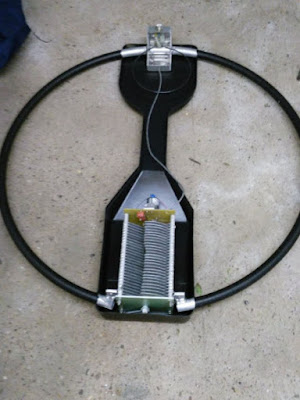Okay! I apologise it has been far too long since I posted anything on this blog, a lot has happened over the last few years and I am still tinkering and dabbling with radio in it's many forms.
Why the resurrection? Well my interest in APRS and packet radio was piqued after Stewart M0SDM who I know through the South Kesteven ARS (SKARS) setup the digipeater/igate MB7UGR in Grantham and as a result there has been more traffic and experimentation by local operators.
Back in 2015 I purchased a couple of PMR sets from a local rally with the intention of converting one Tait T535 into an APRS digipeater/igate, alas it ended up unused on a shelf. I have therefore dug it out and after modifying the diode matrix for the correct frequency 144.800MHz and doing some basic alignment based on the information on David Pye's website. I have interfaced it to a Raspberry Pi which handles the decoding/encoding of the audio signals, processing and internet connection.
The software on the Pi consists of Direwolf as a soundcard based modem/TNC running in AGWPE mode and I am using YAAC to feed the packets to and from the APRS-IS network as well as giving a visual map and access to other functionality such as sending/reading messages.
It might not be pretty, but at least Tait has case back on! M0NRD-10 APRS iGate has been performing well - using direwolf TNC on the Raspberry Pi and YAAC pic.twitter.com/Znr8IzQGpJ
— Andrew Garratt M0NRD 📻 (@nerdsville) January 22, 2021
The audio in/out is done through a standard usb sound dongle, the audio to be transmitted is fed from the headphone output of the usb dongle into the radios microphone input (I soldered a screen lead to the pcb where the fist microphone would plug into the main board) audio out of the radio is taken from the top of the volume pot via a 10uF capacitor, that way turning the volume down on the radio doesn't affect audio into the usb dongle and the audio hasn't passed through the AF amplifier of the radio so should be better for decoding. The PTT is driven from a GPIO pin on the Pi via a simple circuit (which I had built on veroboard for a previous project) it is a simple transistor using an open collector arrangement to pull the PTT to ground.
It has been performing well, receiving packets from the admittedly limited amount of operators sending out APRS using RF rather than using an app such as APRSdroid on their mobile phones and doing it via TCP/IP using the data connections.
I have APRSdroid installed on the Android phone, I was keen to try tracking myself while out driving or walking the dog and doing it via transmission on 144.800MHz. As I wanted to do it while out 'pedestrian mobile' I used one of my neglected Baofeng handheld radios.
Out for lockdown exercise walking the dog, experimenting with APRS, iGate running at home using the converted Tait PMR and RaspberryPi - Baofeng UV82L on VOX connected to phone using simple audio lead running APRSdroid and outputting AFSK pic.twitter.com/n41k402QXc
— Andrew Garratt M0NRD 📻 (@nerdsville) January 18, 2021
It was simple task to use a standard 3.5mm stereo (TRS) to stereo (TRS) audio lead, the sort often used for computer speakers. It is plugged into the microphone input of the radio and the other end plugged into the headset connector of the radio (in this case a UV5RE).
The headset connector of the Android phone is a 3.5mm (TRRS) socket with four connectors rather than 3 of the TRS plug, however this works because the microphone input of the phone is simply grounded by the plug, in this application I am just interest in the audio out of the phone. There may be some issues with some phones not detecting the lead being plugged in or not outputting audio, but in my case it works. If I also wanted to receive and decode I would need to make up another cable.
The radio is set to 144.800MHz and VOX is enabled in the menu, I set it at level 1 sensitivity. The headphone volume of the phone was set to almost full, the Direwolf soundmodem on my iGates indicates the quality of the received audio and it seemed to be okay and not overdriven.
Using the APRSdroid App (paid for version on Google Play Store) it is configured to use the AFSK audio interface, note you will need to give the application permission to access location information via the phones GPS.
To use APRS via internet APRS-IS you will need an APRS passcode for your callsign, the simplest way to get this isn't via emailing websites or app developers but use the numerous websites, I recommend Peter's 2M0SQL webpage however using AFSK audio doesn't require one.
One thing to bear in mind if using in or near your car, disable the Bluetooth Headset if your car supports hands free telephone use as you will get no sound transmitted as I discovered!















































